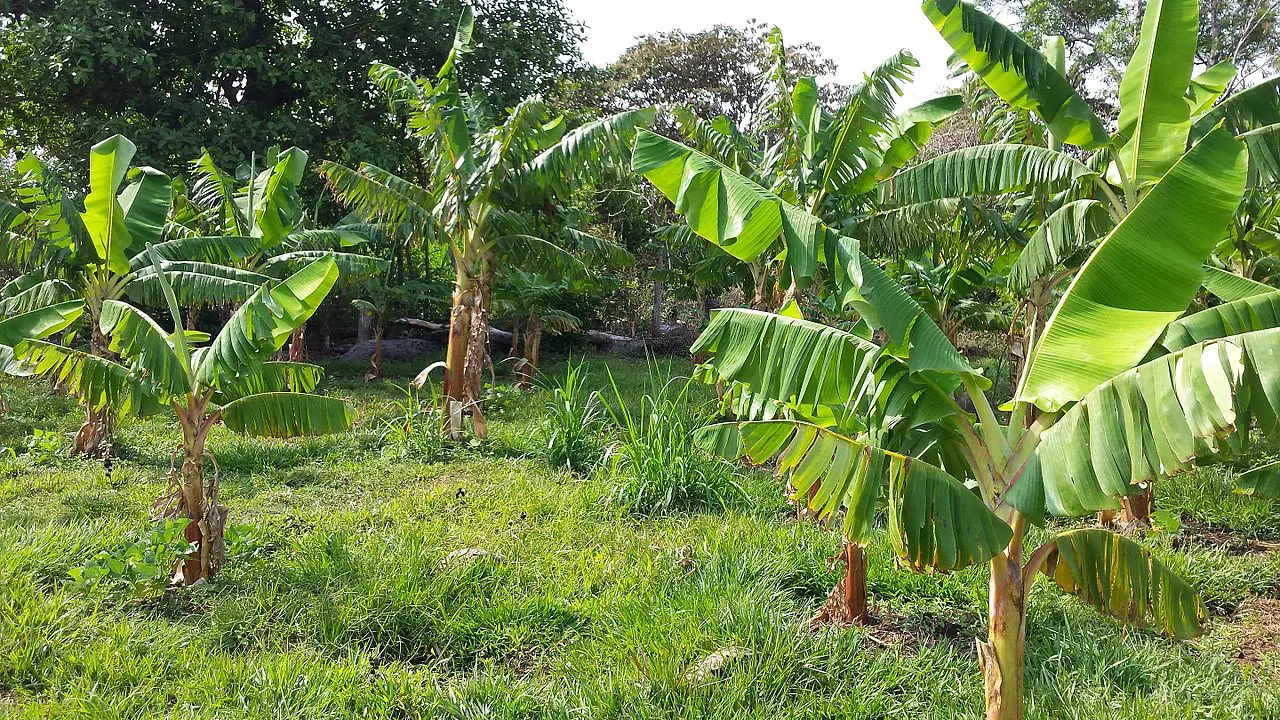
Image – Wikimedia Commons / StayingHn
Have you ever wondered where the delicious plantains and / or bananas that you buy in the supermarket come from? You’re lucky. This time we will talk about this interesting topic and, in addition, We will give you tips so you can have your own banana trees and thus be able to save some money by being able to do without buying this fruit.
You will see how easy it is to have a banana tree in your garden.
Main characteristics of banana trees
The genus of plants that produces these delicious fruits is called Musa. There are numerous varieties: the best known are the Muse velutina which has a pink inflorescence, and the muse basjoo which is the one recommended in somewhat cold areas. There are others, such as Musa acuminata »Dwarf Cavendish» which has abstract dark red spots on the leaves, which is often also found in nurseries as a houseplant.
They are herbaceous, fibrous plants, of very fast growth that can reach ten meters in height in a few years. They require high humidity, especially in the substrate or soil, to be able to develop properly.
Although they can reach 10 meters, they don’t take up much space. The suckers that may come out can be removed and / or transplanted into individual pots. The stem (which acts as a trunk) is thin, and the leaves, which are long, lanceolate and green, grow upwards.
Types of edible banana trees
If you want to have a muse that gives edible bananas, you have to look for these species:
Acuminate muse

Image – Wikimedia Commons / Miya.m
Known as the Malaysian banana or red banana, the Acuminate muse It is a herbaceous plant that reaches a height of 7 meters. The leaves can measure 3 meters by about 60 centimeters wide. The fruit is a false berry 8-13 centimeters long by 3 centimeters in diameter, and has a white pulp with a sweet taste.
In a protected place it can withstand weak frosts down to -2ºC, but it is better that the temperature does not drop below 10ºC.
Muse cavendish

Image – Flickr / FD Richards
Under this name are included different cultivars of Acuminate musesuch as the Dwarf Cavendish, the Gros Michel or the Dwarf Cavendish banana, which is suitable for growing in small gardens and pots. Most of the bananas that are marketed come from them.
They do not resist frost.
Muse x heavenly

Image – Wikimedia / Dinesh Valke from Thane, India
It is the most common banana, and commercialized. Reaches 7 meters in heightand develops leaves up to 3 meters long by 90 centimeters wide. It likes the sun and water, as do all muses, but sadly it can only be grown outside in frost-free climates.
Types of ornamental banana trees
In the event that you want banana trees simply to beautify the garden or terrace, we advise you:
balbisian muse

Image – Wikimedia Commons / David J. Stang
The balbisian muse It is a plant known as the male plantain. It grows up to 8 meters in height, with leaves that are 2-3 meters long by 60 centimeters wide.. Its fruits are 7 to 15 centimeters long by up to 4 centimeters in diameter, and have white pulp full of seeds. It is important to say that these fruits are edible, but this use is not normally given due to the large number of seeds it has.
It is able to withstand the cold, but only resists weak frosts down to -2ºC.
muse basjoo

Image – Wikimedia / Illustratedjc
It is known as the Japanese banana, and it is a perennial plant that reaches 8 meters in height. Its leaves are about 2 meters long by 70 centimeters wide, and it produces fruits with white pulp and full of black seeds. It is one of the most recommended for cold climates, as it resists frosts down to -7ºC at least (in a article it is said that it holds up to -15ºC if its roots are protected with a padding).
coccinea muse

Image – Flickr / Dinesh Valke
Known as the scarlet banana or Chinese red banana, it is a species that reaches 2 meters in heightwhich makes her one of the smallest Muses. It produces inflorescences of a magnificent scarlet color, which gives it its name. Its fruits are spindle-shaped berries measuring 10-12 centimeters, orange-yellow in color, and inedible.
It lives well in sunny areas, and also indoors with lots of light. The minimum temperature it supports is 0ºC.
What are the care that the banana plant requires?
The banana tree is a plant that it is recommended for garden, more than for flowerpot. Although that does not mean that it cannot live or produce fruit in a pot. If it cannot be kept on land, it will be necessary to purchase a large pot so that it can grow and develop properly.
It should be located in full sun, or in a very bright room. As a guideline, it must be irrigated every two or three days if it is in the ground or every week if it is in a pot. The soil or substrate must be kept moist, but not flooded. The frequency of irrigation will vary according to the climate of the area.
Compost is not essential if it is in the ground, but if it is in a pot, whatever is ecological will do. It is very important to follow the manufacturer’s recommendations.
If we talk about pruning, you don’t really need it. However, To make it look pretty, it is highly recommended to cut the dry leaves Whenever necessary. Do this with clean, sanitized scissors.
Do you dare to have your own banana tree?
